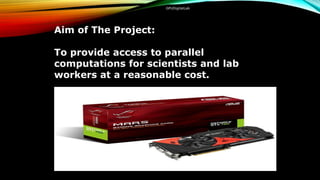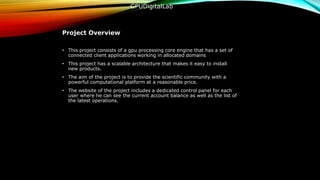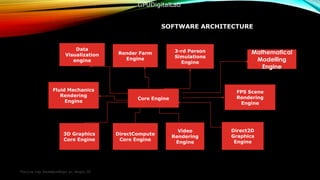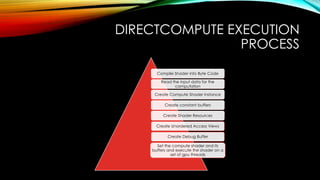Gpu digital lab english version
- 1. GPUDigitalLab Project Manager Gubanov Oleg Igorevich
- 2. GPUDigitalLab Aim of The Project: To provide access to parallel computations for scientists and lab workers at a reasonable cost.
- 3. GPUDigitalLab Solution We, the members of the Axioma Software team, would like to purpose a cluster solution for parallel computations on the GPU. This product will consist of a GPU oriented server that will contain NVIDIA Tesla Graphics Processor at its core. The software would be built upon Microsoft DirectCompute engine. It will be built as a set of client applications that use the power of the GPU core for the computtations. Each application would be oriented to either a problem or a set of problems in modern science and computer graphics. User starts by logging into the server and download the relevant client application. After that the user fills in an input form and sends the data to the server through a secured channel. This architecture allows users to use the power of modern gpu despite the fact they have relatively cheap hardware. ąĀąŠčüčüąĖčÅ, ą│ąŠčĆ. ąĢą║ą░č鹥čĆąĖąĮą▒čāčĆą│, čāą╗. ą£ąĖčĆą░, 32
- 4. ŌĆó This project consists of a gpu processing core engine that has a set of connected client applications working in allocated domains ŌĆó This project has a scalable architecture that makes it easy to install new products. ŌĆó The aim of the project is to provide the scientific community with a powerful computational platform at a reasonable price. ŌĆó The website of the project includes a dedicated control panel for each user where he can see the current account balance as well as the list of the latest operations. Project Overview GPUDigitalLab
- 5. SOFTWARE ARCHITECTURE ąĀąŠčüčüąĖčÅ, ą│ąŠčĆ. ąĢą║ą░č鹥čĆąĖąĮą▒čāčĆą│, čāą╗. ą£ąĖčĆą░, 32 3D Graphics Core Engine DirectCompute Core Engine Video Rendering Engine Direct2D Graphics Engine Core Engine Fluid Mechanics Rendering Engine Data Visualization engine FPS Scene Rendering Engine Render Farm Engine 3-rd Person Simulations Engine Mathematical Modelling Engine GPUDigitalLab
- 6. SOFTWARE CONCEPT ŌĆó At the core of the system there is module that can execute compute shader programs and analyze results ŌĆó There are 3 types of data that we frequently need for our purposes ŌĆó Structured Buffers(used to store numerical data) ŌĆó Shader Resources(used to store texture data ŌĆó Unordered Access View(used to send the collected data to the computational pipeline ŌĆó Compute Shader(a module that collects the data stored in buffers and performs computations based upon a certain algorithm
- 7. PROGRAM STARTUP ŌĆó On startup the program open a login dialog Login Password
- 8. PROGRAM RUNTIME ŌĆó After Logging in the system creates a user session and sets it a unique id. Using the locking mechanism of compute shaders we create a set of writable buffers, shader resources and UAVs(unordered access views). ŌĆó The next step is to prepare our system utilities. Every single utility has a set of modules to control its correct operation. ŌĆó Every single utility of the system requires: ŌĆó Application Manager (launches the utility) ŌĆó Application Executor (controls the operation of the utility) ŌĆó Event Processor (collects errors and records them to .log files)
- 9. PROGRAM STARTUP Initialize the application Initialize the graphics engine Initialize compute shader management class Initialize the system kernel Create the user session controller Create the application domain manger Initialize the application executing modules Create instances of the system utilities as child processes Open a login window
- 10. DIRECT3D INITIALIZATION Create the Rendering Device Create a Render target Create a back buffer Create a depth stencil Create a viewport
- 11. DIRECTCOMPUTE EXECUTION PROCESS Compile Shader into Byte Code Read the input data for the computation Create Compute Shader Instance Create constant buffers Create Shader Resources Create Unordered Access Views Create Debug Buffer Set the compute shader and its buffers and execute the shader on a set of gpu threads
- 12. APPLICATION DOMAIN HAS ŌĆó An initialized 3D Rendering Loop ŌĆó An initialized DirectCompute processing loop ŌĆó A set of buffers for data storage ŌĆó A set of shader resources for texturing ŌĆó A set of compute shader instances ŌĆó An allocated DirectCompute manager class for operations such as data creation ŌĆó An allocated Data archiving module for compressing and decompressing data.
- 13. APPLICATION DOMAIN MANAGER ŌĆó Creates and destroys Domains ŌĆó Collects the data from event processors ŌĆó Keeps the diary of the operations. ŌĆó Controls the threads that are used by the domain
- 14. APPLICATION DOMAIN INSTANCE ŌĆó Holds the objects that are necessary for computations ŌĆó Has a collection of program objects such as buffers, resources and views. ŌĆó Provides a mechanism to edit the data stored in buffers. ŌĆó Provides a secure access to the data for client apps
- 15. APPLICATION DOMAIN INSTANCE ŌĆó An allocated memory pool for application execution ŌĆó Contains a set of predefined objects, buffers and resources. ŌĆó Allows to transfer data securely between different processes. ŌĆó Allows to load program utilities into its threads and control the operation
- 16. USER SESSION CONTROLLER ŌĆó Provides the user with a secure access to system resources ŌĆó Creates a session with a unique session id and stored its in a data archive ŌĆó Starts a thread that processes the actions of the user and sends the results to the system modules
- 17. APPLICATION MANAGER ŌĆó Has an id of a running software process ŌĆó Controls the data that is produces by the process ŌĆó Responsible for starting and terminating systemic widgets ŌĆó Responsible for transferring the data between widget.
- 18. APPLICATION EVENT PROCESSOR ŌĆó Controls the event produced by the application through a named pipe and an allocated reading thread ŌĆó Used the received data to determine the state of the executed applications. ŌĆó Sends the received info about an application to application state manager
- 19. APPLICATION STATE MANGER ŌĆó Responsible for collecting the data from application processors about the state of a module ŌĆó Responsible for informing the other participating modules about a state change for a given module. ŌĆó Responsible for sending the data about the application errors to the main processing loop.
- 20. PROGRAM TYPICAL EXECUTION THREAD Login ŌĆóUser logs into the system Session ŌĆóUser is allocated a session Domains ŌĆóSystem creates a set of domains Applications Applications are loaded into domains Application Selection User selects an application from the panel Data User enters the input parameters into the fields of the dialog and selects the output format Computatio n Data is sent to a computation al engine through a secured channel and processed using a set of predefined algorithms Output User is presented with an output that can be saved to a file
- 21. CLUSTER PRODUCTS OF GPUDIGITALLAB GPUDigitalLa b Core Engine Industrial Simulations Engine Fluid Mechanics Engine Video Encoding and Analysis Engine Physics and Chemistry processes Simulation Engine Crowd visualization Engine Image Processing Engine Render- Farm Engine Data- visualization Engine ąĀąŠčüčüąĖčÅ, ą│ąŠčĆ. ąĢą║ą░č鹥čĆąĖąĮą▒čāčĆą│, čāą╗. ą£ąĖčĆą░, 32 GPUDigitalLab
- 22. 7 STEPS TO USE GPUDIGITALLAB ąĀąŠčüčüąĖčÅ, ą│ąŠčĆ. ąĢą║ą░č鹥čĆąĖąĮą▒čāčĆą│, čāą╗. ą£ąĖčĆą░, 32 Go to www.omenart.ru/ gpu Log into the system or register an account Select the necessary software module from the control panel Input the relevant parameters Calculate or simulate a temporary result Pay for the transaction Output and save the final result to a file GPUDigitalLab
- 23. FLUID DYNAMICS Fluid Mechanics ąĀąŠčüčüąĖčÅ, ą│ąŠčĆ. ąĢą║ą░č鹥čĆąĖąĮą▒čāčĆą│, čāą╗. ą£ąĖčĆą░, 32 GPUDigitalLab
- 24. CHEMICAL REACTIONS SIMULATION ąĀąŠčüčüąĖčÅ, ą│ąŠčĆ. ąĢą║ą░č鹥čĆąĖąĮą▒čāčĆą│, čāą╗. ą£ąĖčĆą░, 32 GPUDigitalLab
- 25. BLOOD CIRCULATION SIMULATOR ąĀąŠčüčüąĖčÅ, ą│ąŠčĆ. ąĢą║ą░č鹥čĆąĖąĮą▒čāčĆą│, čāą╗. ą£ąĖčĆą░, 32 GPUDigitalLab
- 26. CROWD RENDERING SIMULATOR ąĀąŠčüčüąĖčÅ, ą│ąŠčĆ. ąĢą║ą░č鹥čĆąĖąĮą▒čāčĆą│, čāą╗. ą£ąĖčĆą░, 32 GPUDigitalLab
- 27. RAY-TRACING RENDERING SYSTEM ąĀąŠčüčüąĖčÅ, ą│ąŠčĆ. ąĢą║ą░č鹥čĆąĖąĮą▒čāčĆą│, čāą╗. ą£ąĖčĆą░, 32 GPUDigitalLab
- 29. UPCOMING PRODUCTS ąĀąŠčüčüąĖčÅ, ą│ąŠčĆ. ąĢą║ą░č鹥čĆąĖąĮą▒čāčĆą│, čāą╗. ą£ąĖčĆą░, 32 GPUDMOLSimulationEngine ŌĆō software products for molecular configurations computation and dispertion of the electron density. GPUSmartCrowdEngine ŌĆō software to visualize and classify crowds of people for statistical analysis GPUConstructionDemolitionEngine ŌĆō building destruction simulation engine. GPUFireExtinguishingPlanner ŌĆō training tool for a fire brigade or the workers of a factory
- 30. UPCOMING PRODUCTS GPUCrudeOilFlowSimulationEngine ŌĆō oil pipe traffic simulation engine GPUFlueAndColdSimulationEngine ŌĆō cold and flue dispersion simulator. GPUCavitiesSimulationEngine ŌĆō dental diseases simulation engine. GPUChemicalReactionsSimulator ŌĆō a learning game where students have to construct a chemical reaction equation using an interactive periodic table. GPUBloodSimulationEngine ŌĆō blood circulation engine. GPUMedicalDrugSimulation ŌĆō software to simulate an effect of a chemical substance on a human body
- 31. Essential Hardware Server Model: GPX XT10-2260-6GPU CPU: 2 x Six-Core Intel┬« Xeon┬« Processor E5-2630 v2 2.60GHz 15MB Cache (80W) RAM: 8 x 4GB PC3-14900 1866MHz DDR3 ECC Registered DIMM HDD: 250GB SATA 6.0Gb/s 7200RPM - 2.5" - Seagate Constellation.2Ōäó 4 x 800GB Micron M500DC 2.5" SATA 6.0Gb/s Solid State Drive 2 x 1.6TB Intel┬« DC S3500 Series 2.5" SATA 6.0Gb/s Solid State Drive 2 x 800GB Intel┬« DC S3700 Series 2.5" SATA 6.0Gb/s Solid State Drive GPU: NVIDIA┬« TeslaŌäó K40M GPU Computing Accelerator - 12GB GDDR5 - 2880 CUDA Cores Network Card: Intel┬« 10-Gigabit Ethernet Converged Network Adapter X540-T1 (1x RJ-45) UPS: APC Smart-UPS 1000VA LCD 120V - 2U Rackmount Operating System: Microsoft Windows Server 2012 ąĀąŠčüčüąĖčÅ, ą│ąŠčĆ. ąĢą║ą░č鹥čĆąĖąĮą▒čāčĆą│, čāą╗. ą£ąĖčĆą░, 32 ąøą░ą▒ąŠčĆą░č鹊čĆąĖčÅ ą┐ą░čĆą░ą╗ą╗ąĄą╗čīąĮčŗčģ ą▓čŗčćąĖčüą╗ąĄąĮąĖą╣ ąĮą░ GPU
- 32. Essential Hardware DesignerŌĆÖs PC 5 CPU Core i7-4790 (3.6GHz) RAM 32 GB HDD 3 TB GPU NVIDIA GeForce GTX 760 (2GB) Keyboard Genius GK 110001 Mouse Gigabyte GM-M6800 Operating System Windows 8.1 ProgrammerŌĆÖs PC 2 CPU Core i7-4790 (3.6GHz) RAM 16 GB HDD 2 TB GPU NVIDIA GeForce GTX 760 (2GB) Keyboard Genius GK 110001 Mouse Gigabyte GM-M6800 Operating System Windows 8.1
- 33. ąØą░ąĘą▓ą░ąĮąĖąĄ č鹥ą╝čŗ ą┐čĆąĄąĘąĄąĮčéą░čåąĖąĖ Essential Hardware Oculus Rift (Augmented reality glasses) 1 Black Magic Cinema Camera 1 ąĀąŠčüčüąĖčÅ, ą│ąŠčĆ. ąĢą║ą░č鹥čĆąĖąĮą▒čāčĆą│, čāą╗. ą£ąĖčĆą░, 32
- 34. POTENTIAL CUSTOMERS ŌĆó Oil and Gas industries ŌĆó Medical institutions ŌĆó Educational and Research institutions ŌĆó Construction Companies ŌĆó Administration of Yekaterinburg ŌĆó Public event organizers ŌĆó Information technology companies.


































